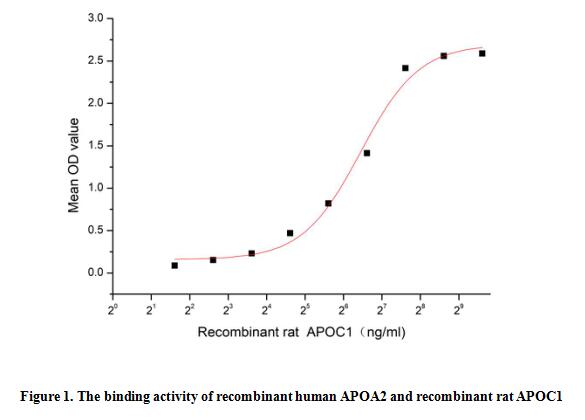Active Apolipoprotein A2 (APOA2) 

Apo-A2; Apolipoprotein A-II; ProapoA-II; Truncated apolipoprotein A-II
- UOM
- FOB US$ 290.00 US$ 725.00 US$ 1,450.00 US$ 4,350.00 US$ 10,875.00
- Quantity
Overview
Properties
- Product No.APA604Hu61
- Organism SpeciesHomo sapiens (Human) Same name, Different species.
- ApplicationsCell culture; Activity Assays.
Research use only - DownloadInstruction Manual
- CategoryMetabolic pathwayEndocrinologyCardiovascular biologyHepatologyNutrition metabolism
- Buffer FormulationPBS, pH7.4, containing 0.01% SKL, 1mM DTT, 5% Trehalose and Proclin300.
- Traits Freeze-dried powder, Purity > 95%
- Isoelectric Point5.9
Sign into your account
Share a new citation as an author
Upload your experimental result
Review

Contact us
Please fill in the blank.
Activity test

Apolipoprotein A2 (APOA2) is a major protein component of serum HDL. It is produced by the liver and is involved in cholesteryl ester formation and cholesterol transport from tissues to the liver. Polymorphisms of APOA2 are associated with disorders of cholesterol and fatty acid metabolism. APOA2 can form disulfide-linked 17 kDa homodimers and heterodimers with other apolipoproteins. Mature human APOA2 shares 96% aa sequence identity with chimpanzee APOA2 and 48% - 66% aa sequence identity with bovine, equine, mouse and rat APOA2. A functional ELISA assay was conducted to detect the interaction of recombinant human APOA2 and recombinant rat APOC1. Briefly, APOC1 was diluted serially in PBS with 0.01% BSA (pH 7.4). Duplicate samples of 100 μl were then transferred to APOA2-coated (1ug/ml, 100 ul/well) microtiter wells and incubated for 1h at 37℃. Wells were washed with PBST and incubated for 1h with anti-APOC1 pAb, then aspirated and washed 3 times. After incubation with HRP labelled secondary antibody for 1h at 37℃, wells were aspirated and washed 5 times. With the addition of substrate solution, wells were incubated 15-25 minutes at 37℃. Finally, add 50 µL stop solution to the wells and read at 450/630nm immediately. The binding activity of recombinant human APOA2 and recombinant rat APOC1 was shown in Figure 1, the concentration of APOC1 that produces 50% optimal binding response is found to be approximately 87.2 ng/mL.
Usage
Reconstitute in 10mM PBS (pH7.4) to a concentration of 0.1-1.0 mg/mL. Do not vortex.
Storage
Avoid repeated freeze/thaw cycles. Store at 2-8°C for one month. Aliquot and store at -80°C for 12 months.
Stability
The thermal stability is described by the loss rate. The loss rate was determined by accelerated thermal degradation test, that is, incubate the protein at 37°C for 48h, and no obvious degradation and precipitation were observed. The loss rate is less than 5% within the expiration date under appropriate storage condition.
Increment services
-
 BCA Protein Quantification Kit
BCA Protein Quantification Kit
-
 Molecular Mass Marker for Protein
Molecular Mass Marker for Protein
-
 Monoclonal Antibody Customized Service
Monoclonal Antibody Customized Service
-
 Polyclonal Antibody Customized Service
Polyclonal Antibody Customized Service
-
 Protein Activity Test Experiment Service
Protein Activity Test Experiment Service
-
 Electrophoretic Mobility Shift Assay (EMSA) Experiment Service
Electrophoretic Mobility Shift Assay (EMSA) Experiment Service
-
 Buffer
Buffer
-
 Lentivirus Packaging Experiment Service
Lentivirus Packaging Experiment Service
-
 Adenovirus Packaging Experiment Service
Adenovirus Packaging Experiment Service
-
 Real Time PCR Experimental Service
Real Time PCR Experimental Service
-
 Spike RBD Protein (S-RBD)
Spike RBD Protein (S-RBD)
-
 Protein G
Protein G
-
 Protein A
Protein A
Citations
- EFECTO PROTECTOR DEL TRATAMIENTO CON NEUROEPO SOBRE LA GLIA DE LA CORTEZA CEREBRAL EN RATONES TRANSGéNICOS CON LA ENFERMEDAD DE ALZHEIMER.Sld:Source
- Differential plasma proteome analysis in patients with high?altitude pulmonary edema at the acute and recovery phasesPubmed:24940404
- Orosomucoid 2 serves for predicting but not for monitoring drug response in patients with knee osteoarthritis treated with chondroitin sulfate/glucosamine …10.1016:j.joca.2018.02.412
- A More Oxidized Plasma Albumin Redox State and Lower Plasma HDL Particle Number Reflect Low-Protein Diet Ingestion in Adult RatsPubmed: 31552421







